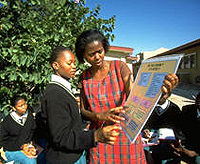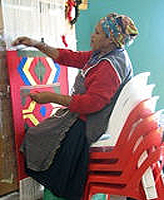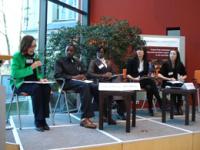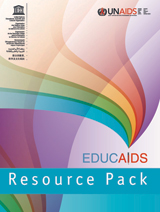
The global online forum will give teachers and their partners the chance to exchange ideas and expertise on how to challenge HIV more effectively
Credit: UNAIDS G. Pirozzi
Teachers have a critical role to play in mounting a successful response to HIV in schools and yet evidence of effective teacher involvement in the challenge to the epidemic is scarce and scattered and lessons learned have not been universally discussed and shared.
In order to review progress made and identify ways forward, UNESCO's International Institute for Educational Planning (IIEP) and the UNAIDS Inter-Agency Task Team on Education are organizing an E-Forum on ‘Teachers and HIV & AIDS: Reviewing achievements, identifying challenges’ from 18 to 29 May 2009.
The forum will bring together a wide range of actors including educational planners, policy-makers, representatives of teachers' unions and teaching staff, networks of teachers living with HIV, civil society groups, donors, UNAIDS cosponsors and other multilateral agencies. They will exchange views and experiences and explore how teachers can capitalize on their influence and expertise to mitigate the effects of an epidemic which is having a profound and negative impact on schools and entire education systems.
In many countries, curricula now include AIDS-related content and teachers themselves are often taking the lead. For example, the South African Democratic Teachers’ Union is building institutional capacity, providing training to support colleagues in examining their own vulnerability to infection, their awareness about HIV and their attitudes towards helping others avoid infection. Educators in general are given an important responsibility to ensure that children and young people acquire essential knowledge, skills and attitudes for prevention and that, in higher prevalence settings, pupils infected with and affected by HIV have access to care and support.

Credit: UNESCO
Without teachers, the endeavour to provide Education for All, which aims to meet the learning needs of every child, youth and adult by 2015, cannot be achieved. However, these professionals face profound challenges, including often difficult working environments (overcrowded classrooms, lack of materials) and poor or non-existent training. In many contexts, particularly in sub-Saharan Africa, teachers are profoundly affected by HIV. According to UNAIDS and WHO, in Zambia, for example, it is estimated that teacher illness (often AIDS-related) and the responsibilities of caring for family members, including attending funerals, account for over 60% of teacher absences. Additionally, stigma and discrimination, gender inequality, concerns around morality, cultural issues and relationships between teachers and students can make the environment in which school-based AIDS education occurs highly complex.
According to a joint statement by Mark Richmond, UNESCO’s Global Coordinator on HIV and AIDS and Mark Bray, Director of UNESCO’s IIEP, “The AIDS epidemic is raising many issues for the teaching profession, particularly in high prevalence settings.”
This forum promises to be a valuable opportunity… to enable the voices of teachers to be heard by all those responding to the challenges posed by HIV.
Mark Richmond, UNESCO’s Global Coordinator on HIV and AIDS and Mark Bray, Director of UNESCO’s IIEP
“This forum promises to be a valuable opportunity for teachers and other stakeholders to share their knowledge and experience and, even more importantly, to enable the voices of teachers to be heard by all those responding to the challenges posed by HIV,” they continued.
The outcomes of the Forum will feed directly into the Spring Meeting of the UNAIDS IATT on Education, hosted by Irish Aid, the Irish government’s assistance programme for developing nations. Taking place in June this year, the meeting has 'Teachers and HIV & AIDS: Reviewing achievements, identifying challenges' as its Symposium theme.
A report on the discussion will also be more widely available at the IIEP's HIV and AIDS Education Clearinghouse.
The Forum will invite the exchange of views on four interrelated sub-topics:
1. Involving teachers in HIV prevention - policy and management implications
2. Coverage and content of pre- and in- service training for teachers
3. The role of teachers in child protection and promotion of safe and healthy school environments
4. Supportive and enabling environments for teachers affected by HIV
All four sub-topics will be accessible over the course of the Forum which will be animated by e-moderators (IIEP and UNAIDS IATT Secretariat staff), with daily syntheses of discussions and commentary to guide further debate on these issues.
To join the Forum, please send an e-mail message to: hiv-aids-clearinghouse@iiep.unesco.org, stating your name, title, organization and nationality. You will then be sent detailed instructions on how to access the Forum and contribute to the discussion.
Please note that you can sign up at any time prior to or during the Forum but that it will be active only from 18 May.
For more information on the IATT Symposium in Ireland, please contact: info-iatt@unesco.org








